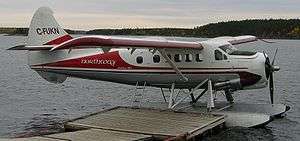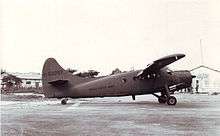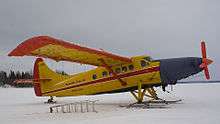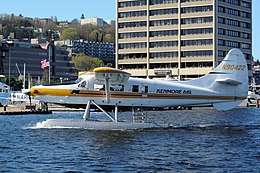de Havilland Canada DHC-3 Otter
The de Havilland Canada DHC-3 Otter is a single-engined, high-wing, propeller-driven, short take-off and landing (STOL) aircraft developed by de Havilland Canada. It was conceived to be capable of performing the same roles as the earlier and highly successful Beaver, including as a bush plane, but is overall a larger aircraft.
| DHC-3 Otter | |
|---|---|
 | |
| Role | STOL utility transport |
| Manufacturer | de Havilland Canada |
| First flight | 12 December 1951 |
| Introduction | 1953 |
| Status | Active |
| Produced | 1951–1967 |
| Number built | 466 |
| Unit cost |
$136,800 |
| Developed from | DHC-2 Beaver |
| Developed into | DHC-6 Twin Otter |
Design and development
The rugged single-engined, high-wing, propeller-driven DHC-3 Otter was conceived in January 1951 by de Havilland Canada as a larger, more powerful version of its highly successful DHC2 Beaver STOL utility transport. Dubbed the "King Beaver" during design, it would be the veritable "one-ton truck" to the Beaver's "half-ton" role.[1]
The Otter received Canadian certification in November 1952 and entered production shortly thereafter. Using the same overall configuration as the Beaver, the new, much heavier design incorporated a longer fuselage, greater-span wing, and cruciform tail. Seating in the main cabin expanded from six to 10 or 11. Power was supplied by a 450-kW (600 hp) Pratt & Whitney R-1340 geared radial. The version used in the Otter was geared for lower propeller revolutions and consequently lower airspeed. The electrical system was 28 volts D.C.
Like the Beaver, the Otter can be fitted with skis or floats. The Otter served as the basis for the very successful Twin Otter, which features two wing-mounted Pratt & Whitney Canada PT6 turboprops. A total of 466 Otters were manufactured.[2]
Operational use





The DHC-3/CC-123/CSR-123 Otter was used until 1980 by the Royal Canadian Air Force and its successor, the Air Command of the Canadian Forces. It was used in Search and Rescue, as the "CSR" denotes Canadian Search (and) Rescue (type 123) and as a light utility transport, "CC" denoting Canadian Cargo. During the Suez Crisis, the Canadian government decided to provide assistance to the United Nations Emergency Force and the Royal Canadian Navy carrier HMCS Magnificent carried 4 Otters from Halifax to Port Said in Egypt early in 1957, with all four flying off unassisted while the ship was at anchor.[3] This was the only occasion when RCAF fixed wing aircraft operated from a Canadian warship.[3] It was also operated on EDO floats on water and skis for winter operations on snow. The EDO floats also had wheels for use on runways (amphibious). It was used as army support dropping supplies by parachute, and also non-parachute low-speed, low-altitude air drops, to support the Canadian Army on manoeuvres. In the end it was operated by the Primary Air Reserve in Montreal, Toronto, Edmonton and Winnipeg, with approximately 10 aircraft at each base, as well as by the RSU (Regular (Forces) Support Units) at those bases. It was usually flown with a single pilot (Commissioned Officer) in the left seat and a Technical Air Crewman (NCO) in the right seat. The Kiowa helicopter replaced it in Air Reserve squadrons.
Although the Otter found ready acceptance in bush airlines, as in a similar scenario to the DHC-2 Beaver, the United States Army soon became the largest operator of the aircraft (184 delivered as the U-1A Otter). Other military users included Australia, Canada, and India, but the primary role of the aircraft as a rugged bush plane continues to this day.
An Otter crossed the South Pole in 1957 (see Commonwealth Trans-Antarctic Expedition). The Otter is also popular in the skydiving community and can be found in many dropzones throughout the world.
Otters were used by Qantas, from 1958 to 1960 in Papua New Guinea. The Qantas aircraft were then transferred to Trans Australian Airlines (TAA) a major Australian domestic airline which operated the Otters in Papua New Guinea until 1966 when they were withdrawn from use. TAA was merged with Qantas in 1990.
Modifications
The most extensively modified Otter was RCAF Otter 3682. After initial service as a standard Search and Rescue aircraft it was used to explore the aerodynamic aspects of STOL. In 1958 it was fitted with flaps so outsized that, with their 45 degree droop, it became known as the Batwing Otter. In addition, its tail-wheel undercarriage was replaced with a high energy- absorption 4-wheel arrangement and a very high vertical tail. The next modification replaced the flaps with fully retractable flaps suitable for cruising flight and high drag was obtained with reverse thrust from a J85 turbojet installed in the fuselage behind the cockpit. The third configuration looked a lot like the future Twin Otter and was the first twin-PT6 fixed-wing installation to fly in May 1963 (A twin PT6-engined helicopter, the Kaman K-1125, had flown in April 1963). The piston engine in the nose was replaced with wing-mounted engines to blow over the flaps.[4][5][6]
Stolairus Aviation of Kelowna, BC, has developed several modifications for the DHC-3 including a STOL Kit, which modifies the wing with a contoured leading edge and drooped wingtips for increased performance. Stolairus has also developed a 400 lb "upgross" kit which increases the gross weight of the DHC-3 to 8,367 lbs on floats.[7]
Some aircraft were converted to turbine power using a PT6A, Walter 601 (manufactured in the Czech Republic), or Garrett/Honeywell TPE331-10, by Texas Turbine Conversions. The Walter M601E-11 Turbine Engine conversion is manufactured and installed by Stolairus Aviation.
A Polish Pezetel radial engine has also been fitted. Re-engined aircraft have been offered since the 1980s by Airtech Canada as the DHC-3/1000 using current-production 1,000 hp (745 kW) PZL ASz-62 IR radials.[8]
Variants
- DHC-3 Otter
- Single-engined STOL utility transport aircraft.
- CSR-123 Otter
- STOL utility transport aircraft for the Royal Canadian Air Force.
- YU-1 Otter
- Six test and evaluation aircraft for the U.S. Army.
- U-1A Otter
- STOL utility transport aircraft for the US Army.
- UC-1 Otter
- STOL utility transport aircraft for the United States Navy. Later redesignated U-1B Otter in 1962.
- DHC-3-T Turbo-Otter
- Otters fitted with either Pratt & Whitney Canada PT6A-27 or Pratt & Whitney Canada PT6A-34 turboprop engine.
- Airtech Canada DHC-3/1000 Otter
- Conversions powered by PZL Kalisz ASz-62IR engines.[8]
- Texas Turbines Super Otter
- Turbine conversion powered by a 900 shp (671 kW) Garret TPE331 turboprop engine
Military operators
- Argentine Air Force: Former operator
- Royal Australian Air Force: Two Otters (RAAF serial A100-1 and 2) were in service with the RAAF from 1961 to 1967. The aircraft were used for passenger and freight transport duties at the Weapons Research Establishment, Woomera, South Australia.
- No. 1 Air Trials Unit
- Bangladesh Air Force: Former operator
- Burma Air Force
- Air Surveillance Service
- Khmer Air Force: Former operator
- Paraguayan Air Force: One DHC-3 donated by Argentina.
- Tanzanian Air Force
- United States Air Force
- United States Army
- United States Navy
- Otter NU-1B is the oldest aircraft in the U.S. Navy, in service at the U.S. Naval Test Pilot School, Patuxent River, Md.[9]
Civil operators

- Royal Canadian Mounted Police
- Lamb Air
- Harbour Air
- Osprey Wings Ltd
- Provincial Airlines
- Air Saguenay
- Vancouver Island Air
- Bearskin Airlines (formerly)
- Philippine Airlines (formerly)
- Talkeetna Air Taxi
- Kenmore Air
- Northwest Seaplanes
- Volcanic Air (Rotorua)
Accidents
As of June 2019, there have been 118 incidents and accidents involving the DHC-3 resulting in 242 deaths.[10] Listed below are a select few of the most notable ones.
- In 1956 two military Otters broke up in mid-air. One had taken off from Downsview and the other from Goose bay. The Otter needs tailplane deflection to balance the pitching moment caused by flap deflection. The flaps were held in position with hydraulic pressure balancing the air loads. Metal contamination in a hydraulic valve allowed the flaps to rapidly retract with the tailplane still fully trimmed. The consequent nose drop was severe enough to cause structural failure. A filter was added to the flap hydraulic system and an interconnection added between the flaps and tailplane to ensure a state of trim.[11]
.jpg)
- On 22 June 1994, a float equipped de Havilland DHC-3 Otter, N13GA, registered to and operated by Wings of Alaska of Juneau, Alaska, crashed into the Taku Inlet, 12 miles east of Juneau. The Air Taxi flight, operating under 14 CFR Part 135 by a Commercial Certificated pilot, last departed the Taku Lodge located on the Taku River, and the destination was the Juneau downtown dock. Instrument meteorological conditions prevailed at the time of the accident and a company flight plan was in effect. The airplane received substantial damage. Six passengers received fatal injuries, one passenger is missing and presumed dead, and the pilot and three passengers received serious injuries.[12]
- On 9 August 2010, a DHC-3T registered to Anchorage-based GCI crashed about 17 miles (27 km) north of Dillingham, Alaska, while en route to a private fishing lodge.[13] Five of the nine people on board were killed, including former Alaska Senator Ted Stevens. Surviving passengers included former NASA administrator Sean O'Keefe and his teenage son, both of whom sustained injuries.[14]
- On 23 September 2011, a single-engined, turbine-powered, amphibious float-equipped de Havilland DHC-3T airplane, N361TT, sustained substantial damage during a go-around and subsequent low-altitude maneuver at Heitman Lake, about 5 miles south-southwest of Kodiak, Alaska. The airplane was being operated by Paklook Air Inc., Kodiak, as a visual flight rules (VFR) on-demand air taxi flight, when the accident occurred. Of the three people aboard, the commercial pilot sustained fatal injuries, one passenger received serious injuries, and the remaining passenger received minor injuries. Visual meteorological conditions prevailed, and company-flight following procedures were in effect. The airplane departed Old Harbor, Alaska, bound for Kodiak. A passenger on the airplane reported that during a go-around on a lake, the airplane struck a tree on the shoreline and crashed. The passenger was able to make a cellphone call, and report the accident to authorities.[15]
- On 7 July 2013, a De Havilland Otter registered to Rediske Air of Nikiski crashed at Soldotna Airport, killing all 10 aboard.[16]
- On 25 June 2015, a Promech Air DHC-3 Otter crashed into the face of a granite cliff near Ella Lake, Alaska, 20 miles (32 km) northeast of Ketchikan. The aircraft carried a pilot and eight passengers who were tourists on a sightseeing excursion from a Holland America Line coastal cruise aboard the cruise ship MS Westerdam. All nine people on board died. The NTSB determined that the pilot had a history of poor decision making and that the company had a compromised culture that resulted in an "operation in which safety competed with performance and revenue".[17][18][19][20]
- On 15 September 2015, Federal Aviation Administration says a De Havilland DHC-3 Turbine Otter on floats carrying 10 people and belonging to Rainbow King Lodge crashed on takeoff at Eastwind Lake, 1 mile north of Iliamna, which is 175 miles SW of Anchorage. Three people were killed in the crash.[21]
- On 13 May 2019, in the 2019 George Inlet, Alaska mid-air collision, a Taquan Air DHC-3 Turbine Otter floatplane collided with a Mountain Air Service DHC-2 Beaver over George Inlet, Alaska, United States, with the loss of 1 passenger aboard the DHC-3 and 5 passengers and crew aboard the DHC-2. The cause of the accident is currently under investigation.
Specifications (landplane)
Data from Jane's All the World's Aircraft 1958-59,[22] Jane's Civil and Military Aircraft Upgrades 1994–95[23]
General characteristics
- Crew: 1 or 2
- Capacity: 9-11 passengers (optional 10th seat in main cabin) / 6 stretchers with 4 seats / 23 stretchers with 7 seats
- Length: 41 ft 10 in (12.75 m)
- Wingspan: 58 ft 0 in (17.68 m)
- Height: 12 ft 7 in (3.84 m)
- seaplane 15 ft 0 in (5 m)
- Cabin length: 16 ft 5 in (5 m)
- Cabin width: 5 ft 2 in (2 m)
- Cabin height: 4 ft 11 in (1 m)
- Cabin volume: 272 cu ft (7.7 m3)
- Stowage compartment volume: 38 cu ft (1.1 m3)
- Wing area: 375 sq ft (34.8 m2)
- Aspect ratio: 8.97
- Airfoil: NACA 63A516 mod[24]
- Empty weight: 4,108 lb (1,863 kg)
- seaplane 4,620 lb (2,096 kg)
- fixed skis 4,361 lb (1,978 kg)
- wheel/ski 44,475 lb (20,174 kg)
- Gross weight: 8,000 lb (3,629 kg)
- seaplane 7,967 lb (3,614 kg)
- Fuel capacity: Total fuel 178 imp gal (214 US gal; 809 l) in :- 51 imp gal (61 US gal; 232 l) front tank ; 85 imp gal (102 US gal; 386 l) middle tank group (two cells) ; 42 imp gal (50 US gal; 191 l) rear tank
- Powerplant: 1 × Pratt & Whitney R-1340-S1H1-G Wasp 9-cylinder air-cooled radial piston engine, 600 hp (450 kW)
- or -S3H1-G (lower supercharger gearing)
- Propellers: 3-bladed Hamilton Standard, 10 ft 10 in (3.30 m) diameter constant-speed propeller
Performance
- Maximum speed: 160 mph (260 km/h, 140 kn) at 5,000 ft (1,524 m)
- seaplane 153 mph (133 kn; 246 km/h) at 5,000 ft (1,524 m)
- skiplane 158 mph (137 kn; 254 km/h) at 5,000 ft (1,524 m)
- Cruise speed: 138 mph (222 km/h, 120 kn) 66% power at 5,000 ft (1,524 m)
- seaplane 129 mph (112 kn; 208 km/h) at 5,000 ft (1,524 m)
- skiplane 133 mph (116 kn; 214 km/h) at 5,000 ft (1,524 m)
- Range: 960 mi (1,540 km, 830 nmi) full internal fuel at 5,000 ft (1,524 m)
- seaplane 863 mi (750 nmi; 1,389 km) full internal fuel at 5,000 ft (1,524 m) seaplane
- Endurance: 9 hours 24 minutes at 5,000 ft (1,524 m)
- seaplane 8 hours 54 minutes at 5,000 ft (1,524 m)
- Service ceiling: 18,800 ft (5,700 m) S1H1-G engine
- 17,400 ft (5,304 m) S3H1-G engine
- Seaplane
- 17,900 ft (5,456 m) seaplane S1H1-G engine
- 16,400 ft (4,999 m) seaplane S3H1-G engine
- Skiplane
- 18,600 ft (5,669 m) skiplane S1H1-G engine
- 17,100 ft (5,212 m) skiplane S3H1-G engine
- Rate of climb: 735 ft/min (3.73 m/s) at sea level
- seaplane 650 ft/min (3.3 m/s) at sea level
- skiplane 690 ft/min (3.5 m/s) at sea level
- skiplane 690 ft/min (3.5 m/s) at sea level
- Take-off distance to 50 ft (15 m): 1,310 ft (399 m)
- seaplane 1,980 ft (604 m)
- Landing distance from 50 ft (15 m): 975 ft (297 m)
- seaplane 12,100 ft (3,688 m)
See also
Related development
Aircraft of comparable role, configuration and era
- Antonov An-2
- Cessna 208 Caravan
- PAC P-750 XSTOL
- Pilatus PC-6 Porter
- Quest Kodiak
- Sherpa Aircraft Sherpa
Related lists
- Bush plane
- List of civil aircraft
- List of non-carrier aircraft flown from aircraft carriers
- STOL
References
- Notes
- Rossiter 1998, p. 55.
- "The De Havilland DHC-3 Otter; a comprehensive information resource". dhc3otter.com. Retrieved July 5, 2017.
- "The Otters and the aircraft carrier". lookoutnewspaper.com. July 22, 2013. Retrieved July 5, 2017.
- https://www.flightglobal.com/pdfarchive/view/1963/1963%20-%200073.html?search=january%20stol%20otter
- Power - The Pratt & Whitney Canada Story, Kenneth H. Sullivan and Larry Milberry, CANAV Books 1989, ISBN 0-921022-01-8, p.147
- The Universal Airplanes - Otter & Twin otter, Sean Rossiter998, Douglas & McIntyre, ISBN 1-55054-637-6, pp. 13-31
- "DHC-3 Otter." Stolairus, Retrieved: February 2, 2012.
- Taylor 1988 p. 17.
- PEO (JSF) Integrated Test Facility Public Affairs (October 24, 2012). "Photo: A generation of naval aviation. The F-35B Lightning II with the NU-1B Otter". Naval Air Systems Command. United States Navy. Retrieved April 21, 2020.
- "Accident Archives". Bureau of Aircraft Accidents Archives. Retrieved 7 June 2019.
- Air Crash - The Clues In The Wreckage, Fred Jones 1985, Roobert Hale Ltd., ISBN 0-7090-2161-5, pp.104-112
- "National Transportation Safety Board Aviation Accident Final Report Accident Number: ANC94FA070". National Transportation Safety Board. June 5, 1995. Retrieved July 5, 2017.
- Trimble, Stephen. "EADS executive survives Alaska air crash, but former senator killed." flightglobal.com, 10 August 2010. Retrieved: 10 August 2010.
- Bohrer, Becky. "Plane crashes in Alaska kills former Alaska Sen. Ted Stevens, ex-NASA chief survives." Archived 2011-07-16 at the Wayback Machine The Associated Press. via 680news.com, 10 August 2010. Retrieved: 10 August 2010.
- "National Transportation Safety Board Aviation Accident Final Report Accident Number: ANC11FA107". National Transportation Safety Board. February 27, 2013. Retrieved July 5, 2017.
- 10 killed in Soldotna plane crash Archived 2013-07-11 at the Wayback Machine, Peninsula Courier, 7 July 2013. Retrieved 7 July 2013.
- St. Claire, Pat (June 25, 2015). "Small plane carrying cruise passengers crashes in Alaska". CNN. Retrieved July 5, 2017.
- Morrison, Greg; Payne, Ed (June 30, 2015). "Authorities identify 9 people killed in Alaska plane crash". CNN. Retrieved July 5, 2017.
- Varandani, Suman, "Alaska Plane Crash: 9 People Killed After Sightseeing Plane Carrying Cruise Ship Passengers Crashes," ibtimes.com, June 26, 2015, 12:27 AM EDT.
- Grady, Mary (25 April 2017). "NTSB Cites "Company Culture" In Fatal Crash". AVweb. Retrieved 26 April 2017.
- D'Oro, Rachel (September 15, 2015). "Fishing lodge's floatplane crashes in Alaska; 3 dead, 7 hurt". Associated Press. Archived from the original on March 4, 2016. Retrieved July 5, 2017.
- Bridgman, Leonard, ed. (1958). Jane's All the World's Aircraft 1958-59. London: Jane's All the World's Aircraft Publishing Co. Ltd. pp. 127–128.
- Michell 1994, p.24.
- Lednicer, David. "The Incomplete Guide to Airfoil Usage". m-selig.ae.illinois.edu. Retrieved 16 April 2019.
- Bibliography
- Hayes, Karl E. DHC-3 Otter – A History (CD-ROM). Crakaig, Killiney Hill Road, Killiney, Co. Dublin, Ireland: Karl E. Hayes Publisher, 2006. (also available via CANAV Books, Toronto)
- Hotson, Fred W. The de Havilland Canada Story. Toronto: CANAV Books, 1983. ISBN 0-07-549483-3.
- Michell, Simon. (ed.). Jane's Civil and Military Aircraft Upgrades 1994–95. Coulsdon, UK: Jane's Information Group, 1994. ISBN 0-7106-1208-7.
- Milberry, Larry. Aviation In Canada. Toronto: McGraw-Hill Ryerson Ltd., 1979. ISBN 0-07-082778-8.
- Molson, Ken M. and Harold A. Taylor. Canadian Aircraft Since 1909. Stittsville, Ontario: Canada's Wings, Inc., 1982. ISBN 0-920002-11-0.
- Rossiter, Sean. The Immortal Beaver: The World's Greatest Bush Plane. Vancouver: Douglas & McIntyre, 1999. ISBN 1-55054-724-0.
- Rossiter, Sean. Otter & Twin Otter: The Universal Airplanes. Vancouver: Douglas & McIntyre, 1998. ISBN 1-55054-637-6.
- Taylor, John W.R., ed. Jane's All The World's Aircraft 1988–89. Coulsdon, UK: Jane's Defence Data, 1988. ISBN 0-7106-0867-5.
External links
| Wikimedia Commons has media related to De Havilland Canada DHC-3 Otter. |